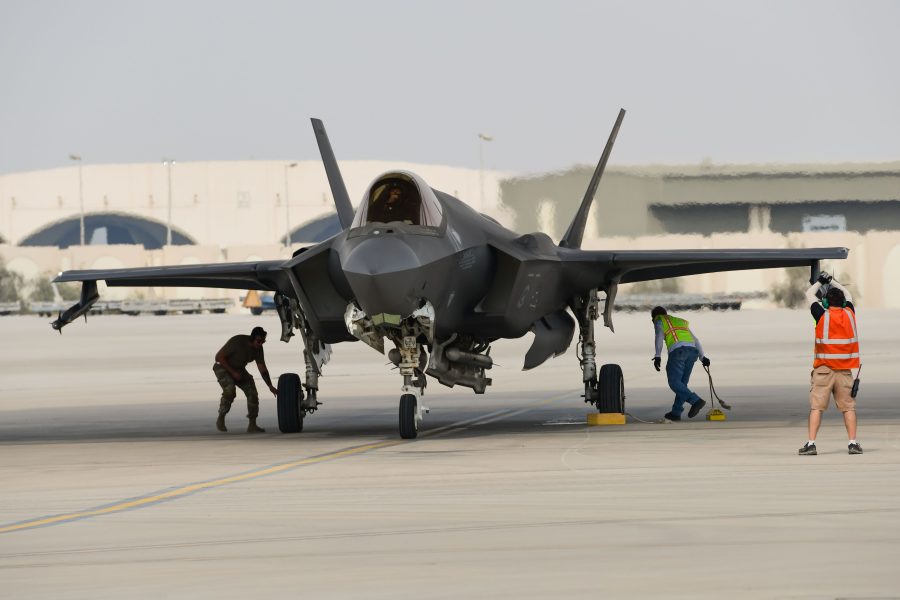Lockheed Martin doesn’t expect to resume F-35 fighter deliveries until late this summer, but the Pentagon’s Joint Program Office and F-35 partners are considering accepting jets before then, without the fully validated “Tech Refresh 3” software.
During a Jan. 23 earnings call, Lockheed president, chairman and chief executive officer Jim Taiclet said the company is still targeting the second quarter of 2024 for the TR-3 software to finish testing and be accepted.
“However, we now believe that the third quarter may be a more likely scenario for a TR-3 software acceptance,” he said.
Lockheed is likely to deliver between 75 and 110 F-35s in 2024, versus a planned 156, Taiclet said. However, he said he does not see a need to ease back on production, despite the building backlog of completed jets.
Since July, Lockheed has been building TR-3-configured jets at its Fort Worth, Texas plant. But the TR-3 suite—processors and software on which the F-35 Block 4 upgrade rests—is still being tested, a year after it was expected to be cleared.
Because the software is not yet accepted, Lockheed has been storing aircraft that have been completed. Absent the payments on those jets, Lockheed’s F-35 revenues declined $400 million in 2023, although the company made up for that with stronger revenues from its Skunk Works advanced products unit and F-16 sales.
“We delivered 18 F-35 aircraft in the Technology Refresh Two, or TR-2, configuration in the fourth quarter, bringing the 2023 total [delivered] to 98 jets,” Taiclet said. He did not specify how many TR-3 jets are being stored, but industry sources said the figure is above 60 airplanes. For operational security reasons, the JPO said it will not reveal where the jets are being stored.
Both U.S. services and foreign customers are anxious to get the aircraft, however, and the delay is disrupting plans to modernize various fighter fleets around the world.
A JPO spokesperson said that while the program office is “focused on delivering capable aircraft to the warfighters,” it is exploring a “truncation plan to accept aircraft ahead of full validation” of TR-3 capabilities.
“Any aircraft involved and delivered as part of the truncation plan will provide valuable capability to the warfighters while TR-3 completes final verification and validation,” the spokesperson said. No timeline was offered about when aircraft with waivers could be delivered.
More than 90 percent of TR-3 functionality is under flight test, Taiclet said, “and we are further advancing the software integration to include additional aircraft and mission subsystems.”
Neither the JPO nor Lockheed could immediately say whether Taiclet’s projection of deliveries resuming in the third quarter is based on the assumption that those aircraft will be delivered before full testing and validation is completed.
Either way, “the resulting aircraft delivery range for 2024 [of] between 75 and 110 … requires the TR-3 hardware suppliers to keep pace with production demands, both this year and in the future, Taiclet said.
Although TR-3 is taking longer than anticipated to get through flight test and software validation, Lockheed is “taking the time and attention to get this technology insertion right the first time, because it will be absolutely worth it,” Taiclet said.
“The step function technological advances of TR-3 will provide our customers with the onboard digital infrastructure of data storage, data processing, and pilot user interface to provide unmatched capabilities for many years to come,” he said. These will include new air-to-air and air-to-ground weapons, “advanced sensing, jamming, and cybersecurity capabilities” and more accurate target recognition “to achieve this level of reliable capability for the long run,” he said.
It’s “essential” that F-35 production rates be maintained, Taiclet said, despite the slowdown in deliveries. He added that “we can continue at this rate,” which was set last year at a notional 156 F-35s per year.
The key to achieving program goals is “full transparency,” he said, “and realizing the reality of the situation. When you’re trying to drive this much technology into an air vehicle, you’ve got to be honest about the schedule. What can industry do? What can the test and evaluation community handle in the various militaries to accept that technology? And what’s the supply chain capacity?
“We’re being brutally honest with our services and our Joint Program Office to what we think industry can do, with us and our airplane,” said Taiclet, noting that industry includes the subcontractors who make the radar, electro-optical system, and electronic warfare suite, among other systems.
“We cannot afford to be over-optimistic in the ability to deliver these technologies as rapidly as one might like,” he added.
Taiclet also said international demand for the F-35 remain strong, with a recent follow-on order from the Republic of Korea, which will buy another 20 of the fighters. Belgium has also received the first of its aircraft, which will be one of more than 600 F-35s in service in Europe by the 2030s.
